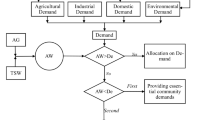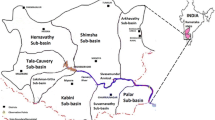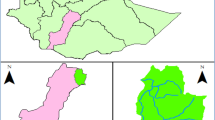Abstract
The limitation of freshwater resources and the growing demand for water, make the issue of water resource development planning and water allocation among stakeholders even more important. Ideally, water allocation should be economically efficient and socially equitable. In this study, a water allocation model is presented in an integrated framework that considers the interaction of water supply and demand according to economic and social factors. To achieve this, a reliability-based multi-objective optimization - simulation approach has been employed. The objective functions of the problem are: 1) maximizing GDP from agricultural sectors and 2) maximizing social equality in different provinces of the basin (measured using the Williamson coefficient). The fair development and allocation among the shared provinces in the basin can reduce conflicts in the region. Karkheh basin has been considered as a case study and decision variables of the problem are area under cultivation of agricultural development sectors in different provinces. The results show that, without harming the income of the agricultural sector, the spatial distribution of development projects can be done in such a way that equality (according to income level and the number of people working in each province) is achieved. One of the solutions of Pareto front compared to previous studies shows that, in addition to an increase of about 12% of the objective function 1 (GDP), the value of the objective function 2 (Williamson coefficient) decreased from 1.19 to 0.98. This indicates a decrease in income inequality among the provinces of the basin.






Similar content being viewed by others
Data Availability
Not applicable
References
Arab Amiri M, Mesgari MS (2019) Spatial variability analysis of precipitation and its concentration in Chaharmahal and Bakhtiari province, Iran. Theor Appl Climatol 137(3–4):2905–2914. https://doi.org/10.1007/s00704-019-02787-y
Arab Amiri M, Conoscenti C, Mesgari MS (2018) Improving the accuracy of rainfall prediction using a regionalization approach and neural networks. Kuwait Journal of Science 45(4):66–75
Babel MS, Gupta AD, Nayak DK (2005) A model for optimal allocation of water to competing demands. Water Resour Manag 19(6):693–712
Beltrán Tapia F, Martinez-Galarraga J (2020) Inequality and growth in a developing economy: evidence from regional data (Spain, 1860–1930). Soc Sci Hist 44(1):169–192. https://doi.org/10.1017/ssh.2019.44
Calow, R., & Mason, N. (2014). The real water crisis: inequality in a fast changing world. Overseas Development Institute. https://www.odi.org/sites/odi.org.uk/files/odi-assets/publications-opinion-files/8953.pdf
Coello CAC, Pulido GT, Lechuga MS (2004) Handling multiple objectives with particle swarm optimization. IEEE Trans Evol Comput 8:256–279
Cuaresma JC, Doppelhofer G, Feldkircher M (2012) The determinants of economic growth in European regions. Reg Stud 48:44–67. https://doi.org/10.1080/00343404.2012.678824
Gluschenko K (2018) Measuring regional inequality: to weight or not to weight? Spat Econ Anal 13(1):36–59
Guan H, Chen L, Huang S, Yan C, Wang Y (2020) Multi-objective optimal allocation of water resources based on ‘three red lines’ in Qinzhou. China, Water Policy
Habibi Davijani H, Banihabib ME, Nadjafzadeh AA, Hashemi SR (2016) Multi-objective optimization model for the allocation of water resources in arid regions based on the maximization of socioeconomic efficiency. Water Resour Manag 30(3):927–946
Hatamkhani A, Moridi A (2019) Multi-objective optimization of hydropower and agricultural development at river basin scale. Water Resour Manage 33:4431–4450. https://doi.org/10.1007/s11269-019-02365-x
Hu Z, Chen Y, Yao L, Wei C, Li C (2016) Optimal allocation of regional water resources: from a perspective of equity efficiency tradeoff. Resour Conserv Recycl 109:102–113
Iran Water and Power Resources Development Company. (2011) Systematic studies of Karkheh Basin
Kennedy J, and Eberhart R C (1995) Particle swarm optimization. Proc.IEEE Int. Conf. on Neural Networks IEEE Service Center Piscataway NJ 1942–1948
Li, X., Wang, X., Guo, H., & Ma, W. (2020). Multi-water resources optimal allocation based on multi-objective uncertain chance-constrained programming model. Water Resources Management, 1-19
Liu D, Chen X, Lou Z (2010) A model for the optimal allocation of water resources in a saltwater intrusion area: a case study in Pearl River Delta in China. Water Resour Manag 24(1):63–81
Naidoo, J., & Wills, J. (2008). Health studies: an introduction. Basingstoke: Palgrave Macmillan. Planning Commission of India (1997). 9th five year plan (Vol. 2). http://planningcommission.nic.in/plans/planrel/fiveyr/9th/vol2/v2c3-7.htm
Roozbahani R, Schreider S, Abbasi B (2013) Economic sharing of basin water resources between competing stakeholders. Water Resour Manag 27(8):2965–2988
Roozbahani R, Schreider S, Abbasi B (2015) Optimal water allocation through a multi-objective compromise between environmental, social, and economic preferences. Environ Model Softw 64:18–30
Sherafatpour Z, Roozbahani A, Hasani Y (2019) Agricultural water allocation by integration of hydro-economic modeling with Bayesian networks and random forest approaches. Water Resources Management 33(7):2277–2299
Sieber J, Purkey D (2011) WEAP: water evaluation and planning system. Stockholm Environment Institute, US Center, User Guide Somerville
The Statistical Yearbook of Iran (2017). Statistics Center of Iran
Tian J, Guo S, Liu D, Pan Z, Hong X (2019) A fair approach for multi-objective water resources allocation. Water Resour Manag 33(10):3633–3653
UNDP (2006). Human development report 2006, beyond scarcity: power, poverty and the global water crisis. New York: Palgrave Macmillan. http://www.undp.org/content/dam/undp/library/corporate/HDR/2006%20Global%20HDR/HDR-2006-Beyond%20scarcity-Power-poverty-and-the-global-water-crisis.pdf
United Nations (2015). Goal 6: Ensure access to water and sanitation for all. http://www.un.org/sustainabledevelopment/water-and-sanitation/
Varela-Ortega C, Blanco-Gutiérrez I, Swartz CH, Downing TE (2011) Balancing groundwater conservation and rural livelihoods under water and climate uncertainties: an integrated hydro-economic modeling framework. Global Environmental Change 21(2):604–619
Williamson JG (1965) Regional inequality and the process of national development. J. Econ Dev Cult Chang 13:1–84
Acknowledgments
The authors thank reviewers for helpful comments in improving the manuscript.
Author information
Authors and Affiliations
Contributions
Both authors conceived and designed the study. Material preparation, data collection and analysis were performed by Amir Hatamkhani. Both authors wrote the manuscript and approved the final draft.
Corresponding author
Ethics declarations
Conflict of Interest
The authors have no conflicts of interest to declare that are relevant to the content of this article.
Competing Interests
The authors declare no competing interests.
Ethical Approval
Not applicable
Consent to Participate
Not applicable
Consent for Publication
Herewith, we declare our consent for our manuscript to be published in “Water Resources Management” journal.
Additional information
Publisher’s Note
Springer Nature remains neutral with regard to jurisdictional claims in published maps and institutional affiliations.
Rights and permissions
About this article
Cite this article
Hatamkhani, A., Moridi, A. Optimal Development of Agricultural Sectors in the Basin Based on Economic Efficiency and Social Equality. Water Resour Manage 35, 917–932 (2021). https://doi.org/10.1007/s11269-020-02754-7
Received:
Accepted:
Published:
Issue Date:
DOI: https://doi.org/10.1007/s11269-020-02754-7




